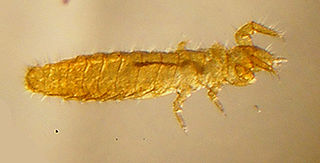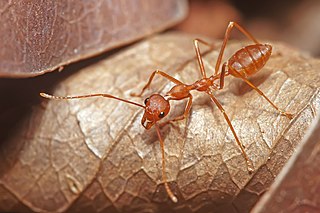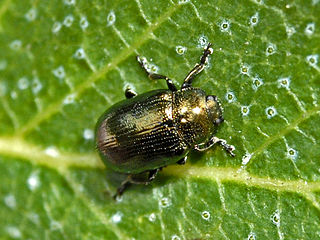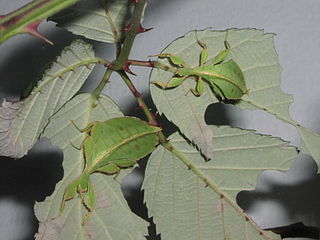
Beetles are insects that form the order Coleoptera, in the superorder Endopterygota. Their front pair of wings are hardened into wing-cases, elytra, distinguishing them from most other insects. The Coleoptera, with about 400,000 described species, is the largest of all orders, constituting almost 40% of described insects and 25% of all known animal species; new species are discovered frequently, with estimates suggesting that there are between 0.9 and 2.1 million total species. Found in almost every habitat except the sea and the polar regions, they interact with their ecosystems in several ways: beetles often feed on plants and fungi, break down animal and plant debris, and eat other invertebrates. Some species are serious agricultural pests, such as the Colorado potato beetle, while others such as Coccinellidae eat aphids, scale insects, thrips, and other plant-sucking insects that damage crops.

Butterflies (Rhopalocera) are insects that have large, often brightly coloured wings, and a conspicuous, fluttering flight. The group comprises the superfamilies Hedyloidea and Papilionoidea. The oldest butterfly fossils have been dated to the Paleocene, about 56 million years ago, though they may have originated earlier.

The Protura, or proturans, and sometimes nicknamed coneheads, are very small, soil-dwelling animals, so inconspicuous they were not noticed until the 20th century. The Protura constitute an order of hexapods that were previously regarded as insects, and sometimes treated as a class in their own right.

Leaf warblers are small insectivorous passerine birds belonging to the genus Phylloscopus.

A pupa is the life stage of some insects undergoing transformation between immature and mature stages. Insects that go through a pupal stage are holometabolous: they go through four distinct stages in their life cycle, the stages thereof being egg, larva, pupa, and imago. The processes of entering and completing the pupal stage are controlled by the insect's hormones, especially juvenile hormone, prothoracicotropic hormone, and ecdysone. The act of becoming a pupa is called pupation, and the act of emerging from the pupal case is called eclosion or emergence.

The Phasmatodea are an order of insects whose members are variously known as stick insects, stick-bugs, walkingsticks, stick animals, or bug sticks. They are also occasionally referred to as Devil's darning needles, although this name is shared by both dragonflies and crane flies. They can be generally referred to as phasmatodeans, phasmids, or ghost insects, with phasmids in the family Phylliidae called leaf insects, leaf-bugs, walking leaves, or bug leaves. The group's name is derived from the Ancient Greek φάσμα phasma, meaning an apparition or phantom, referring to their resemblance to vegetation while in fact being animals. Their natural camouflage makes them difficult for predators to detect; still, many species have one of several secondary lines of defense in the form of startle displays, spines or toxic secretions. Stick insects from the genera Phryganistria, Ctenomorpha, and Phobaeticus include the world's longest insects.

Dicaeum is a genus of birds in the flowerpecker family Dicaeidae, a group of passerines tropical southern Asia and Australasia from India east to the Philippines and south to Australia. The genus Dicaeum is closely related to the genus Prionochilus and forms a monophyletic group.

Fungus-growing ants comprise all the known fungus-growing ant species participating in ant–fungus mutualism. They are known for cutting grasses and leaves, carrying them to their colonies' nests, and using them to grow fungus on which they later feed.

Oecophylla smaragdina is a species of arboreal ant found in tropical Asia and Australia. These ants form colonies with multiple nests in trees, each nest being made of leaves stitched together using the silk produced by the ant larvae: hence the name 'oecophylla' [Greek for 'leaf-house'].

Xylella fastidiosa is an aerobic, Gram-negative bacterium of the genus Xylella. It is a plant pathogen, that grows in the water transport tissues of plants' and is transmitted exclusively by xylem sap-feeding insects such as sharpshooters and spittlebugs. Many plant diseases are due to infections of X. fastidiosa, including bacterial leaf scorch, oleander leaf scorch, coffee leaf scorch (CLS), alfalfa dwarf, phony peach disease, and the economically important Pierce's disease of grapes (PD), olive quick decline syndrome (OQDS), and citrus variegated chlorosis (CVC). While the largest outbreaks of X. fastidiosa–related diseases have occurred in the Americas and Europe, this pathogen has also been found in Taiwan, Israel, and a few other countries worldwide.

The family Phylliidae contains the extant true leaf insects or walking leaves, which include some of the most remarkably camouflaged leaf mimics (mimesis) in the entire animal kingdom. They occur from South Asia through Southeast Asia to Australia. Earlier sources treat Phylliidae as a much larger taxon, containing genera in what are presently considered to be several different families.

A leaf miner is any one of numerous species of insects in which the larval stage lives in, and eats, the leaf tissue of plants. The vast majority of leaf-mining insects are moths (Lepidoptera), sawflies, and flies (Diptera). Some beetles also exhibit this behavior.

The plushcap is a species of bird in the tanager family Thraupidae and it is the only member of the genus Catamblyrhynchus.

The São Tomé leaf-nosed bat is a species of bat in the family Hipposideridae. It is endemic to the island of São Tomé, in the Gulf of Guinea off the western coast of Africa. The bat's natural habitats are subtropical or tropical moist lowland forests and caves.

Phyllium is the largest and most widespread genus of leaf insects in the family Phylliidae (Phasmatodea). They can be found in Sundaland, Philippine Islands, Wallacea, and Australasia.

Phratora vitellinae, the brassy leaf beetle, formerly Phyllodecta vitellinae, is a beetle of the family Chrysomelidae found in Europe and Asia. It feeds on Populus and Salix species. The evolution of its host plant preferences and the mechanism by which it uses host plant chemicals to make a larval defensive secretion have been the subject of intense study by research groups in Europe and the Nordic countries.

Eumolpini is a tribe of leaf beetles in the subfamily Eumolpinae. It is the largest tribe in the subfamily, with approximately 170 genera found worldwide. Members of the tribe almost always have a longitudinal median groove on the pygidium, which possibly helps to keep the elytra locked at rest. They also generally have a subglabrous body, as well as appendiculate pretarsal claws.

Typophorini is a tribe of leaf beetles in the subfamily Eumolpinae. The tribe contains approximately 100 genera, which are found worldwide. Members of the tribe are mainly characterized by notches on the tibiae of the middle and hind legs, which are sometimes referred to as antenna cleaners. They also generally have a subglabrous body, as well as bifid pretarsal claws.

Cryptophyllium is a genus of leaf insects in the tribe Phylliini, described in 2021. Its distribution is probably incomplete, but includes southern China, Sri Lanka, Indo-China, Malesia and western Pacific islands.

The Obrimini are the most species-rich tribe of the Phasmatodea family of the Heteropterygidae native to Southeast Asia.




















